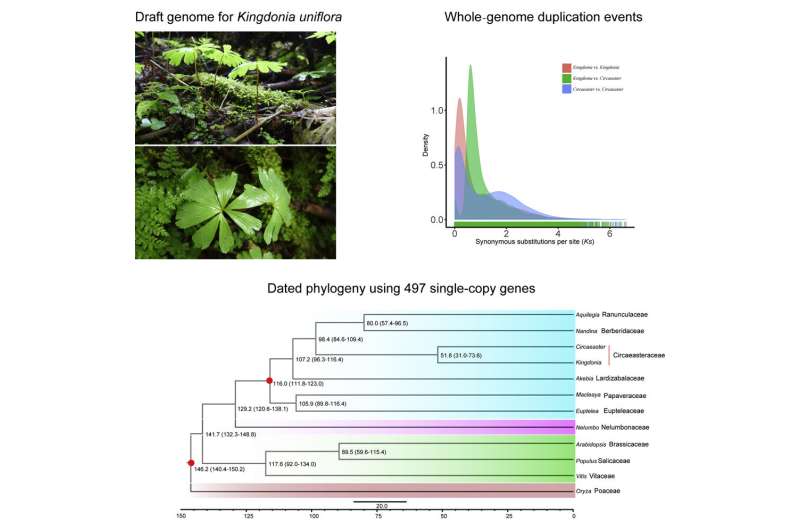Whole-genome analyses for Kingdonia. Credit: WBG
Kingdonia uniflora Balf. f. and W.W. Sm. (Circaeasteraceae, Ranunculales), an alpine herb, has a very narrow distribution in the world and is listed as an endangered species in China. The habitat of it represents an ecological environment of primeval forest with few disturbances.
To investigate the endangered mechanisms of K. uniflora, a research group led by Prof. Wang Hengchang from the Wuhan Botanical Garden and Sun Hang from the Kunming Institute of Botany assembled a 1,004.7-Mb draft genome (encoding 43,301 genes) of K. uniflora.
Significant overrepresentation in gene families associated with DNA repair, while underrepresentation in gene families related to stress response, and loss of most plastid ndh genes. The asexual reproductive system and overrepresentation of DNA repair genes together reduced genetic diversity of K. uniflora.
Long-term adaptation to a relatively stable ecological environment may have resulted in the underrepresentation of gene families associated with stress response and functional loss of ndh genes, and have led to degeneration of adaptive ability to changing environments.
Results speculated that changing climate, shrinking habitats, and low adaptive ability to environmental changes together contributed to the extremely narrow distribution of K. uniflora.
This research entitled "Genome Sequencing of the Endangered Kingdonia uniflora (Circaeasteraceae, Ranunculales) Reveals Potential Mechanisms of Evolutionary Specialization" was published in iScience.
More information: Yanxia Sun et al. Genome Sequencing of the Endangered Kingdonia uniflora (Circaeasteraceae, Ranunculales) Reveals Potential Mechanisms of Evolutionary Specialization, iScience (2020). DOI: 10.1016/j.isci.2020.101124
Provided by Chinese Academy of Sciences























